
PHOCUS
Real-time digital phono EQ
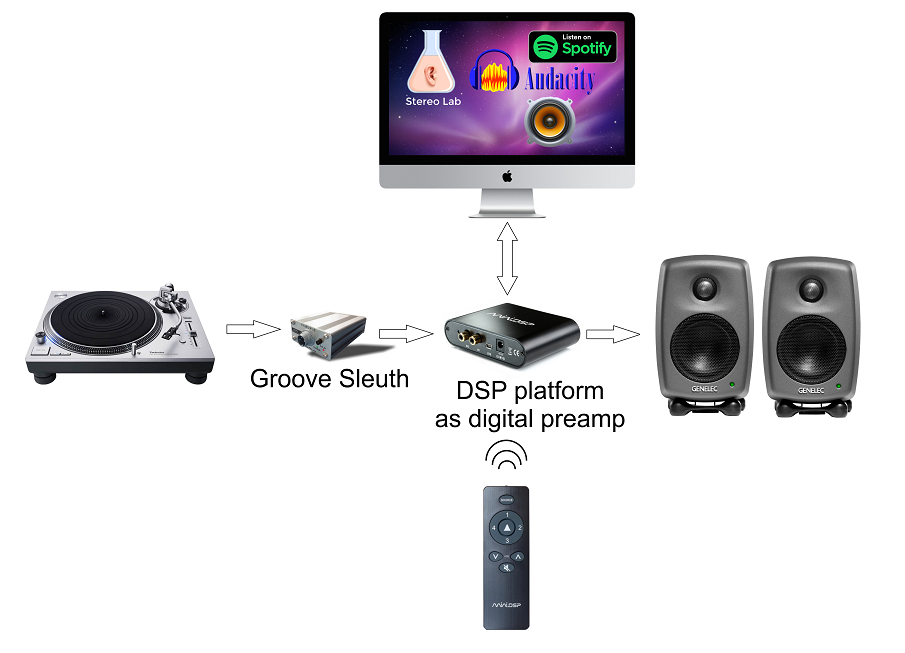 By employing a Groove Sleuth phono preamplifier to feed a third-party DSP platform acting as a digital preamplifier, you can enjoy the accuracy, stabilty and performance of digital signal processing (DSP) when replaying your records in real time.
By employing a Groove Sleuth phono preamplifier to feed a third-party DSP platform acting as a digital preamplifier, you can enjoy the accuracy, stabilty and performance of digital signal processing (DSP) when replaying your records in real time.
The Phædrus Audio PHOCUS software preamplifier is at the heart of a convenient, high-quality, small home-music setup in which a turntable may be seamlessly integrated with digital and streaming audio sources and coupled to advanced DSP techniques like room-correction.
The PHOCUS software preamplifier is supplied free-of-charge (on request) with the Groove Sleuth LOCKDOWN, Mk. II and the Groove Sleuth MICRO.
miniDSP & PHOCUS preamplifier
A third-party DSP platform may be used to implement RIAA (and other recording characteristic) equalisation; as well as other preamplifier functions such as source select and volume control (via IR remote).
The Groove Sleuth phono preamplifier is required to provide the correct impedance match to the phono cartridge and sufficient gain to drive the A to D converter without over-loading, but not to perform recording equalisation correction.
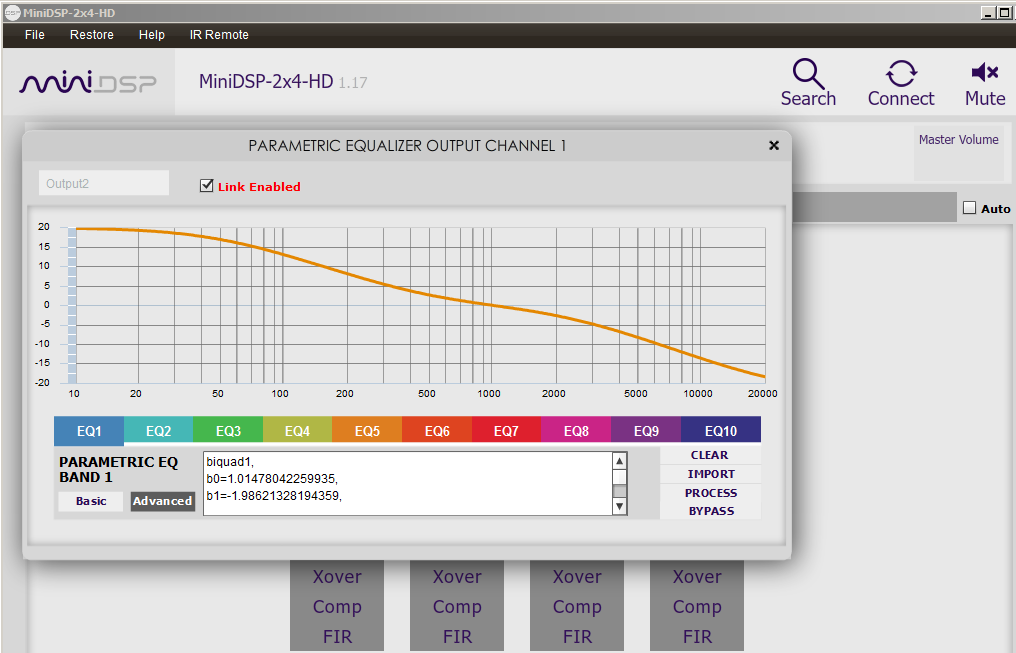
A suitable and popular DSP engine is the 2X4HD platform from miniDSP of Hong Kong. This DSP may be used to implement accurate RIAA equalisation using 2nd order linear recursive filtering.¹ The plug-in interface (not required for use) is illustrated left.
The platform is powerful enough that it can simultaneously host advanced DSP techniques, like room-correction.
The PHOCUS software preamplifier is a series of software configurations for the miniDSP 2X4HD platform designed as a versatile preamplifier for selection, control and equalisation of analogue and digital sources. It further permits the seamless integration of the Stereo Lab by acting as a audio soundcard interface for needle-drop recordings.
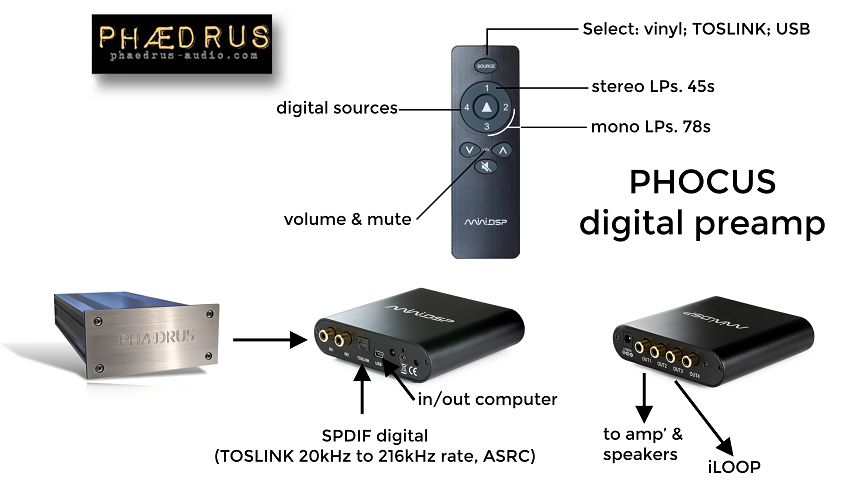
Four personalities
Four separate preamplifier configurations provide the best equalisation options for:
- Stereo LPs;
- Mono LPs (TELDEC EQ);
- 78 RPM records;³
- Digital sources which may be input to the amplifier via an optical TOSLINK connector, or from a computer via USB.
Click for the manual for the PHOCUS preamplifier.
Integration with Stereo Lab
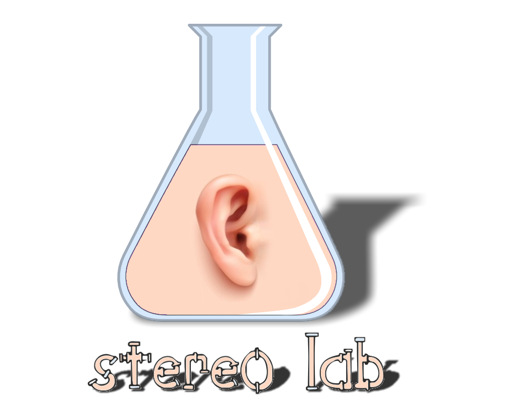 In all four of the PHOCUS configurations, channels 3 and 4 of the miniDSP 2X4HD are programmed to be a copy of the two-channel input signals (iLOOP).
In all four of the PHOCUS configurations, channels 3 and 4 of the miniDSP 2X4HD are programmed to be a copy of the two-channel input signals (iLOOP).
These are available as analogue signals at output 3 and 4 of the DSP platform (0dBFS = 2V RMS) and to any computer connected via USB. The computer interface is XMOS asynchronous USB audio, 44.1 to 192 kHz, USB Audio Class 2 compliant. (ASIO driver for Windows, driverless for Mac OS X.)
These iLOOP signals are programmed so that channels 3 and 4 may be used for making unequalised needle-drop recordings to a connected computer whilst monitoring (with equalisation applied) via channels 1 & 2.
A screen capture of an Audacity session (below) illustrates equalised and non-equalised signals from a vinyl needle-drop being recorded simultaneously from the PHOCUS to a connected computer.
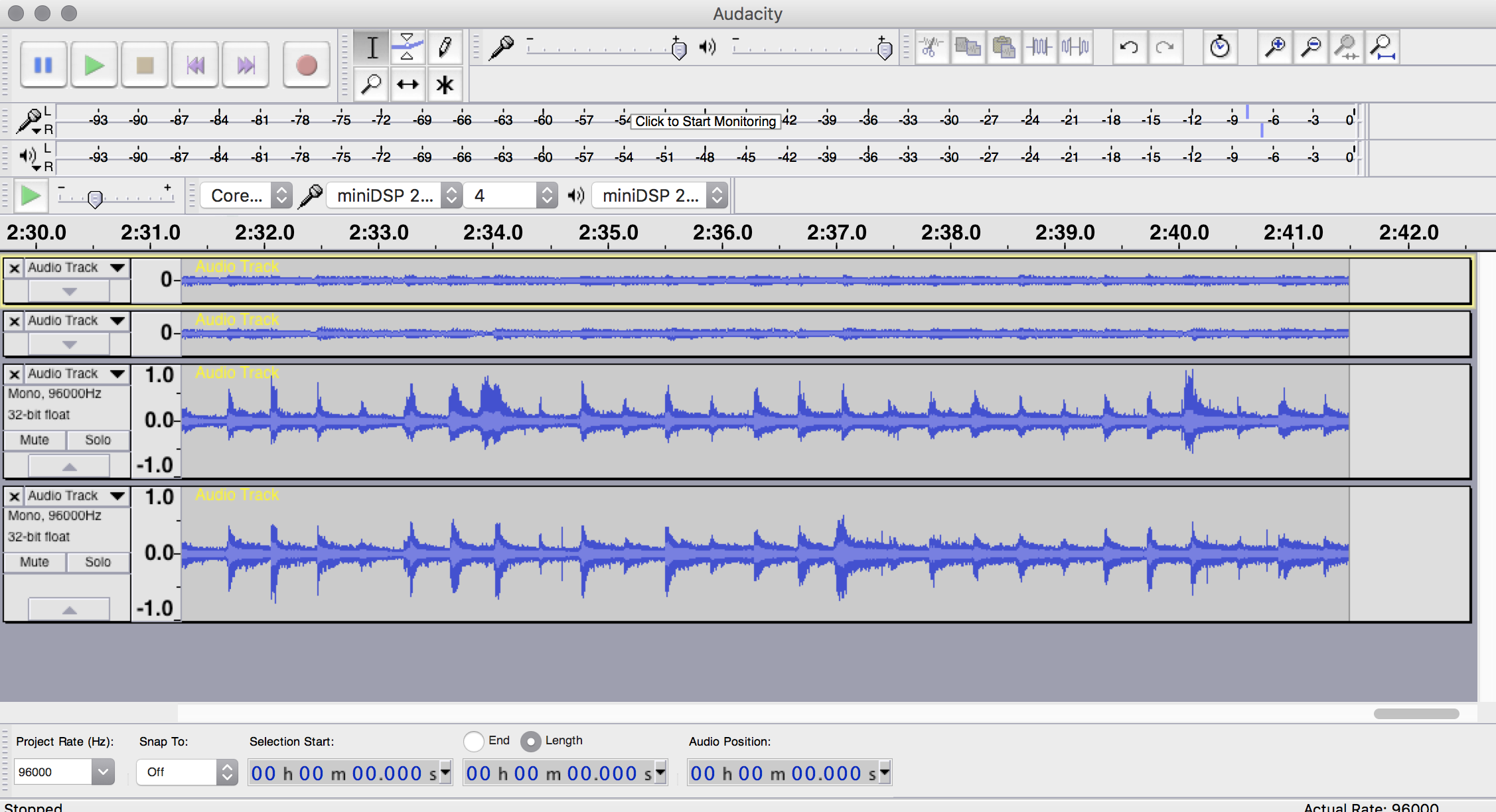
Alignment
All the Groove Sleuth preamplifiers are aligned for 0dBFS = 2V RMS (default jumper setting in miniDSP 2X4HD).
The Groove Sleuth preamplifiers will drive the A to D within a couple of dB of full-scale from maximum velocity modulation, thereby just leaving a bit of headroom for pathological signals (severe record damage, needle-down thump etc.).²
Cartridge compensation
 The phono cartridge is the most fragile link in reproduction from records. The technology is more like watchmaking than normal audio work. And the analogy with watchmaking is interesting because it also explains how, just like wrist watches, prices of cartridges go from about the price of a full-price CD to the price of a car.
The phono cartridge is the most fragile link in reproduction from records. The technology is more like watchmaking than normal audio work. And the analogy with watchmaking is interesting because it also explains how, just like wrist watches, prices of cartridges go from about the price of a full-price CD to the price of a car.
The good news is that using PHOCUS software preamplifier, it is possible to improve the performance from your cartridge whatever your budget by complementary signal processing; at least in terms of frequency response variations.
Cartridge compensation is implemented in multi-tap FIR filters, the convolution parameters being determined by Pspatial Audio from extensive cartridge tests. We offer generic compensations for various cartridges.4. Cartridge compensation is supplied as a data file (in IEEE 754 single-precision binary floating-point format). This is uploaded to the miniDSP 2X4HD platform with the associated 2X4HD1 plug-in. The files contain the 1024 convolution coëfficients.
At launch (Jan 2012), we have generic compensation filters for the cartridges listed in end-note. 4. We will continue to add to this list in later versions of the software.
Rumble-filter
The PHOCUS software preamplifier incoporates rumble-filtering with 12dB/octave filters with 15Hz turnover in a third, cascaded biquad filter. These are disabled on shipping but may be enabled in the 2X4HD1 plug-in. These filters are not in the path to iLOOP outputs (3 and 4 of the miniDSP 2X4HD DSP platform) so that the high-quality, linear-phase rumble filter in Stereo Lab may be employed. See The Needle-Drop Handbook for more information on rumble filtering.
Soft PHOCUS
The Phaedrus Audio PHOCUS is software only. The miniDSP 2X4HD DSP platform is available directly from miniDSP of Hong Kong. The 2X4HD1 plug-in should be purchased. The IR remote control is a worthwhile option too.
The 2X4HD1 plug-in provides tools for the programming of the Analog Devices SHARC ADSP21489 DSP which runs in the miniDSP platform. We encourage those interested in the world of digital signal programming to develop their own configurations and filters. The miniDSP platform is powerful enough to incorporate many other features along with the PHOCUS functionality. For example: active-crossovers; and room-correction equalisation.
The Phædrus Audio PHOCUS product is a shortcut for those who don't wish to delve into the world of digital filter programming - or a baseline configuration for those who do. The RIAA/TELDEC and 78 RPM equalisations run in cascaded biquadratic digital filters on the platform. These filters were developed using iterative CAD techniques to offer a tight match to ideal analogue equalisation networks.³
The Phædrus Audio PHOCUS software preamplifieris made available as four, XML configuration files which must be uploaded to the DSP unit via a computer (PC or Mac) running the miniDSP 2X4HD1 plug-in. These files are free (on request) to customers of the Groove Sleuth MICRO, MK. II and Groove Sleuth LOCKDOWN preamplifiers. They may be purchased independently by contacting sales@phaedrus-audio.com. Cartridge correction filters are available as binary files (IEEE 754 single-precision binary floating-point format.)
Click for the manual for the PHOCUS preamplifier.
References and notes
1. Record replay RIAA correction in the digital domain by Scott Wurcer. Linear Audio Vol 10 - September 2015.
2. The output level is also a function of the cartridge sensitivity and this is beyond our control. Extra gain can be configured in the input module of the 2X4HD1 plug-in to compensate for low output cartridges.
3. TELDEC equalisation is based on three time-constants: 3180µs, 318µs and 50µs. The 78 RPM (shellac records) equalisation curve was developed with the benefit of Pspatial Audio's years of experience of working with shellac era records. We worked with them to develop to a compromise equalisation, known as the Pspatial Audio Universal Shellac characteristic which serves for the majority of 78s.
If shellac records are replayed using the RIAA curve, the low-frequencies are over-boosted and this results in exagerrated bass and rumble due to surface roughness of the record-lathe bearings. The Pspatial Audio Universal Shellac characteristic offers much less bass-boost and a rapidly falling characteristic at very low frequencies which helps supress any bearing rumble.
The spectrum of the groove noise from a 78 RPM record rises from about 500Hz to very high frequencies: in fact, to frequencies way beyond the recording technology of the nineteen-thiries and nineteen-forties, which was limited to about 7kHz after which the recording characteristic was said to be constant acceleration.
The Pspatial Audio Universal Shellac characteristic maintains the flat characteristic until about 7kHz whereupon it falls rapidly so that surface noise however is drastically reduced.
By contrast RIAA characteristic also attenuates the treble at much too low a frequency which leads to unacceptably "woolly, or unfocused" reproduction.
See The Needle-Drop Handbook for comprehensive information on recording characteristics.
4. At this point in time we have generic compensation filters for the following cartridges:
- Audio Technica AT-F3 Moving Coil cartridge
- Audio Technica AT-OC9 III Moving Coil cartridge
- Audio Technica AT33EV Moving Coil cartridge
- Audio Technica AT440MLa Moving Magnet cartridge
- Audio Technica AT-VM95 (all styli)
- Benz Micro ACE SL Moving Coil cartridge
- Clearaudio Concept Moving Coil cartridge
- Clearaudio Concept V2 Moving Magnet cartridge
- Clearaudio Talismann V2 Gold Moving Coil cartridge
- Denon DL-160 high output Moving Coil cartridge
- Denon DL-304 Moving Coil cartridge
- Dynavector Karat 17D3 Moving Coil cartridge
- EMT Jubilee JSD 6 Moving Coil cartridge
- Goldring 1012GX Moving Magnet cartridge
- Goldring 2500 Moving Magnet cartridge
- Goldring Legacy Moving Coil cartridge
- Grado Prestige Gold 1 Moving Iron cartridge
- Heed Zene Moving Coil cartridge
- Kiseki Blue N.S. Moving Coil cartridge
- Koetsu Urushi Sky Blue Moving Coil cartridge
- Koetsu Urushi Vermillion Moving Coil catridge
- Linn Kandid Moving Coil cartridge
- Lyra Delos Moving Coil cartridge
- Lyra Etna SL Moving Coil cartridge
- Nagaoka MP-150 Moving Permalloy cartridge
- Nagaoka MP-500 Moving Permalloy cartridge
- Ortofon 2M Black Moving Magnet cartridge
- Ortofon 2M Blue Moving Magnet cartridge
- Ortofon 2M Red Moving Magnet cartridge
- Ortofon Cadenza Red Moving Magnet cartridge
- Ortofon Rondo Blue Moving Coil cartridge
- Ortofon MC Anna Moving Coil cartridge
- Ortofon MC Anna Diamond Moving Coil cartridge
- Ortofon's 2M Black
- Ortofon's 2M Bronze
- Ortofon's 2M Red
- Ortofon's Cadenza Blue
- Ortofon's Cadenza Bronze
- Phædrus Audio PHLUX-II
- Shure M97xE Moving Magnet cartridge
- Sumiko Blackbird high output Moving Coil cartridge
- Sumiko Blue Point Special Evo III high output Moving Coil cartridge
- VAN DEN HUL DDT -II Moving Coil cartridge
- VAN DEN HUL The Crimson Moving Coil cartridge
We will continue to add to this list in later versions of the software.

Links
Back to home page
Address all mail to sales@phaedrus-audio.com


Maidstone . Kent . UK .
© Phædrus Audio 2021. All rights reserved.
 By employing a Groove Sleuth phono preamplifier to feed a third-party DSP platform acting as a digital preamplifier, you can enjoy the accuracy, stabilty and performance of digital signal processing (DSP) when replaying your records in real time.
By employing a Groove Sleuth phono preamplifier to feed a third-party DSP platform acting as a digital preamplifier, you can enjoy the accuracy, stabilty and performance of digital signal processing (DSP) when replaying your records in real time.

 In all four of the PHOCUS configurations, channels 3 and 4 of the miniDSP 2X4HD are programmed to be a copy of the two-channel input signals (iLOOP).
In all four of the PHOCUS configurations, channels 3 and 4 of the miniDSP 2X4HD are programmed to be a copy of the two-channel input signals (iLOOP).


